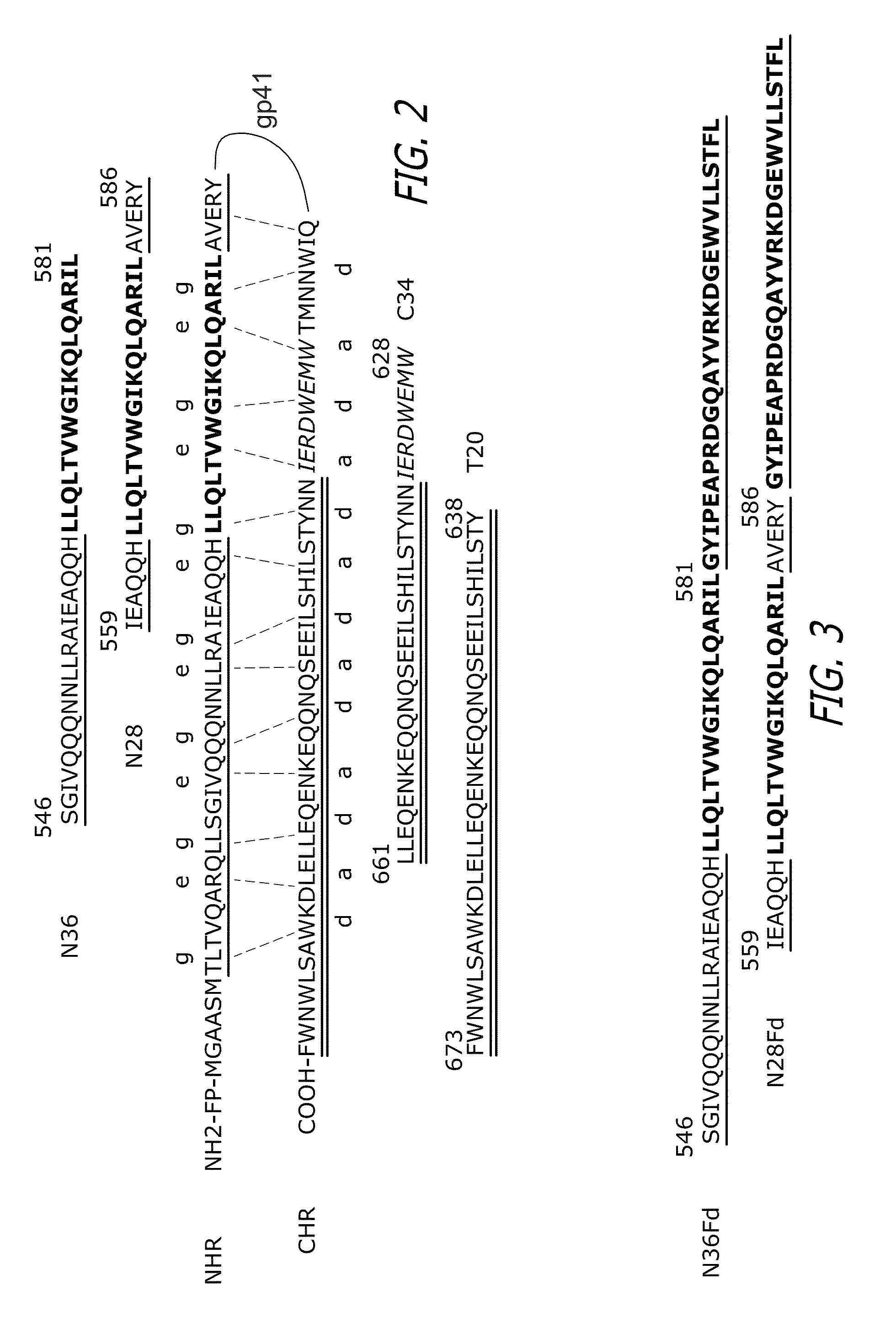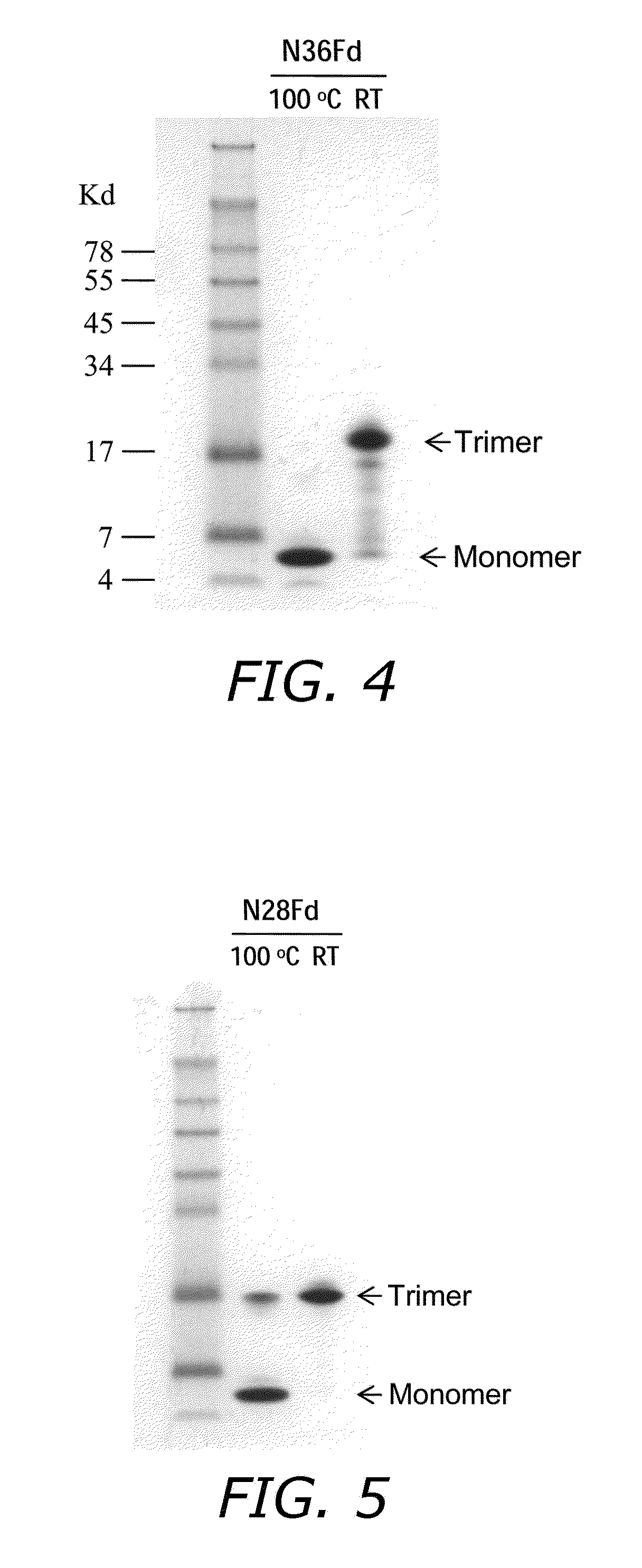Stabilized trimeric HIV-1 gp41 fusion polypeptides comprising the N-terminal heptad repeat (NHR) and foldon (FD) trimerization motif
a trimeric hiv-1 and polypeptide technology, applied in the direction of peptide/protein ingredients, peptide sources, drug compositions, etc., can solve the problems of inability to respond to current rtis and pis, limited clinical use of t20, and inability to stabilize the fusion of gp41, so as to prevent infection of a subject
- Summary
- Abstract
- Description
- Claims
- Application Information
AI Technical Summary
Benefits of technology
Problems solved by technology
Method used
Image
Examples
example 1
Design of N36Fd and N28Fd Trimers
[0083]N-peptides derived from the HIV-1 gp41 NHR are commonly regarded as weak HIV-1 fusion inhibitors because free N-peptides have a tendency to aggregate and thus cannot fold into a stable trimeric α-helical conformation in physiological solution. The 27-mer Fd sequence (SEQ ID NO: 29) was used to facilitate the trimerization of the N-peptides N36 and N28 by fusing the Fd sequence directly to the C-terminus of N36 (SEQ ID NO: 30) or N28 (SEQ ID NO: 31) without any linking sequence (FIG. 3). N36 was chosen for this study because of its ability to form highly stable 6-HB with peptides derived from gp41 CHR. This peptide includes a 17-amino acid sequence that provides a critical hydrophobic pocket for the interaction between gp41 NHR and CHR (FIG. 2, in bold). The N28 peptide was selected because of an AVERY (aa 582-586) sequence adjacent to the C-terminus of the pocket-formation sequence which may be important for gp41 6-HB formation. Specifically, t...
example 2
Expression, Purification and Characterization of N36Fd and N28Fd
[0084]The DNA fragments of N36 and N28 were amplified by PCR using the Platinum PCR SuperMix High Fidelity kit (Invitrogen, Carlsbad, Calif.) from a pHBX-env / wt plasmid with a forward primer containing a BamH1 site and a reverse primer that had no restriction site. The fragment of Fd was produced by annealing a long synthetic forward primer coding the last 9 amino acids of the N-peptide (N36 or N28) and the Fd with its complement, a long reverse primer with an Xhol1 site. Then the two overlapping fragments were mixed and used as templates for another PCR reaction using the BamH1 forward primer and a shorter reverse primer coding the last few amino acids of the Fd with an Xhol1 site. The product was purified using a gel extraction kit (QIAGEN, Valencia, Calif.), digested with BamH1 and Xhol1 enzymes (TaKaRa Bio, Madison, Wis.), and cloned into a pGEX6p-1 vector (QIAGEN). The sequence was confirmed by DNA sequencing.
[0085...
example 3
N36Fd and N28Fd are in a Stable Alpha-Helical Conformation
[0087]The secondary conformational structure of N36, N36Fd, N28, N28Fd and Fd peptides was analyzed by circular dichroism (CD) spectroscopy as previously described. All the N-peptides were diluted in ddH2O (pH 7.0) and all the C-peptides or the mixture of the N- and C-peptides were diluted in 50 mM sodium phosphate and 150 mM NaCl (PBS, pH 7.2) to a final concentration of 10 μM. The individual peptides and their mixtures were incubated in a 37° C. water bath for 0.5 h before testing. The spectra of each sample were acquired on Jasco spectropolarimeter (Model J-715, Jasco Inc., Japan) at RT, using a 5.0 nm bandwidth, 0.1 nm resolution, 0.1 cm path length, 4.0 sec response time, and a 50 nm / min scanning speed, and were corrected by a subtraction of the background corresponding to the solvent. The spectrum of the N-peptide portion in the individual N36Fd or N28Fd, or in the N36Fd / C34 or N28Fd / C34 mixture, was calculated by subtr...
PUM
| Property | Measurement | Unit |
|---|---|---|
| pH | aaaaa | aaaaa |
| constant voltage | aaaaa | aaaaa |
| path length | aaaaa | aaaaa |
Abstract
Description
Claims
Application Information
 Login to View More
Login to View More - R&D
- Intellectual Property
- Life Sciences
- Materials
- Tech Scout
- Unparalleled Data Quality
- Higher Quality Content
- 60% Fewer Hallucinations
Browse by: Latest US Patents, China's latest patents, Technical Efficacy Thesaurus, Application Domain, Technology Topic, Popular Technical Reports.
© 2025 PatSnap. All rights reserved.Legal|Privacy policy|Modern Slavery Act Transparency Statement|Sitemap|About US| Contact US: help@patsnap.com



